|
By
foot
When the Scheme began in 1949, access to remote regions
was gained on foot by geologists, hydrologists, and
surveyors. Packhorses were used extensively to carry
materials, equipment, and supplies over difficult terrain,
to the men and women who lived and worked in the isolation
of the Australian Alps. The packhorse could be loaded
with supplies of food, building materials for the construction
of huts, trade tools and scientific instruments. The
horses were also used for reconnaissance surveys that
were undertaken by geologists, hydrologists and surveyors.
Roads
In time, access roads were established to facilitate
the movement of large construction machines, materials
and food supplies. Roads had to be established that
would allow the transport of materials in a range of
extreme weather conditions. In its road making activities,
the SMAdeveloped techniques in and standards for:
- box
cuttings: a part of the road where both sides are
in a cutting and the batters are nearly vertical.
- dished
cross drains: a shallow paved drain across a road.
 Box cutting (SMA, 1967: fig 3)
Box cutting (SMA, 1967: fig 3) |
The
SMAwere conscious of soil conservation. When roads
were built particular attention was paid to batters.
The steep cut face was often spread with straw and asphalt
to assist rapid establishment of vegetation sown and
planted on very difficult slopes.
More
than half a million trees, hundreds of thousands of
cuttings and 20,000 shrubs were grown in Authority
nurseries and planted in the field. About 200 tons
of specially selected grass and clover seed were sown
and 1,500 tons of fertilisers were used to make sure
that new vegetation was established quickly. (SMA,
1999: 8)
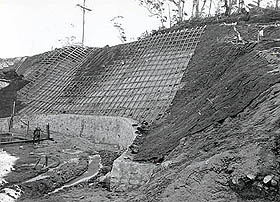
Soil
conservation of steep cut face, 1962.
(SMA, 1999: 8)
|
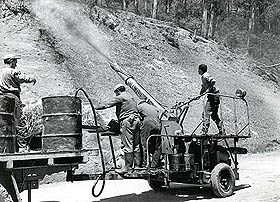
Spreading
straw and asphalt on cut face, 1957.
(SMA, 1999: 9) |
Transport
Later, the SMAestablished a fleet of heavy transport
vehicles, aircraft, utilities and sedans, snow ploughs
and snow cats. The SMAmaintained a large public relations
program and during the construction phase, special vehicles
were used to transport thousands of visitors around
the Scheme.
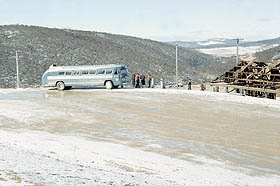
Public relations bus (SMA)
|
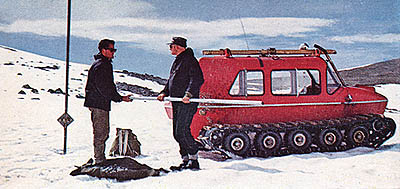
Snowcat
(SMA, 1961: 27) |
The
Scheme was a major testing ground for the Landrover
in Australia and more than 13 000 had been imported
to the country by the mid-1950s.
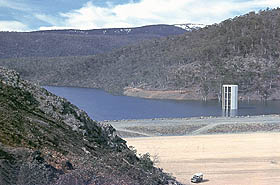
Landrover at Eucembene Dam. Photo:
Bayram Ali
(Powerhouse Museum Collection) |
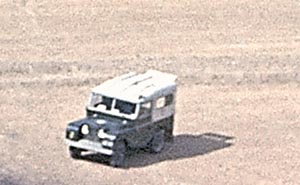 |
Plant
equipment
Euclids
The Scheme necessitated the use of huge stocks of modern
heavy plant equipment that was unprecedented in Australia.
Here are two of the 27 British-made Euclid rear-dumping
trucks bought by the NSW Public Works Department for
use on the Eucumbene Dam project. These 15-ton trucks
were used to transport rock and soil for the construction
of the dam wall. Euclid pioneered the design of off-highway,
heavy construction vehicles in America in the 1930s.
Euclid proudly declared their Snowy association in newspaper
advertisements of the time. When the American company
Kaiser, Walsh, Perini and Raymond took over from the
Public Works Department they fitted hungry boards
to the sides of these trucks to increase their capacity
and speed up the project.

Photo: Bayram Ali
(Powerhouse Museum Collection) |
Tournapulls
Clay was excavated from a soil quarry downstream of
the dam wall and carted to the site in trucks and earthmovers.
This photograph shows one of the many American-made
Lima 1201 excavators used on the job (left) with a bottom-dumping
earthmover (right). These tournapulls were designed
by the US company Le Tourneau and built in Sydney by
Le Tourneau-Westinghouse. They were sold as state-of-the-art
high-speed earthmovers capable of travelling at up to
80 kilometres an hour. They emptied their loads while
moving, thereby speeding up the process of horizontal
filling. Tournapulls were operated by a complex electrical
system with dumping and steering activated by button.
They were also among the most dangerous heavy plant
machines on the Scheme.
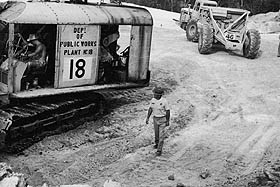
Photo: Bayram Ali
(Powerhouse Museum Collection) |
This
picture shows a smashed Tournapull at Eucumbene Dam
site in the mid-1950s. These bottom-dumping earth transporters
were nicknamed widowmakers because of their fickle handling
characteristics at speed.

Photo: Bayram Ali
(Powerhouse Museum Collection) |
Aircraft
The de Havilland Canada DHC-2 Beaver aircraft were used
to deliver medical supplies, mail, food and equipment
to many areas throughout the scheme that were inaccessible
by road. There were airstrips throughout the Snowy and
these were used to deliver passengers as well as supplies.
When conditions were unsuitable deliveries were dropped.
There were two aircraft and they were built in Canada.

Beaver
aircraft dropping supply (SMA, 1960)
|
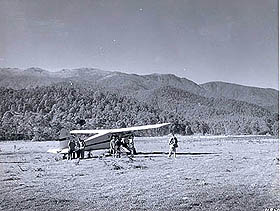
Beaver
aircraft on the landing area at Reed's Flat (SMA,
1958) |
|